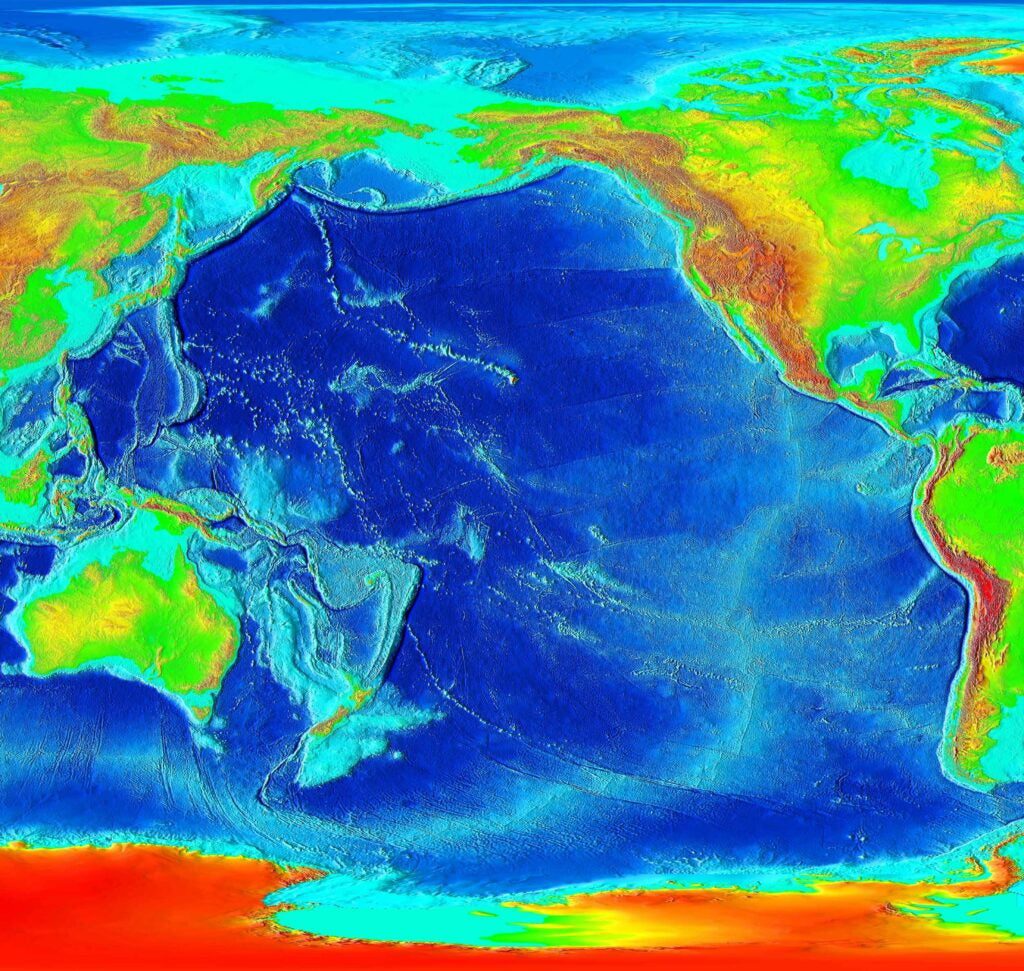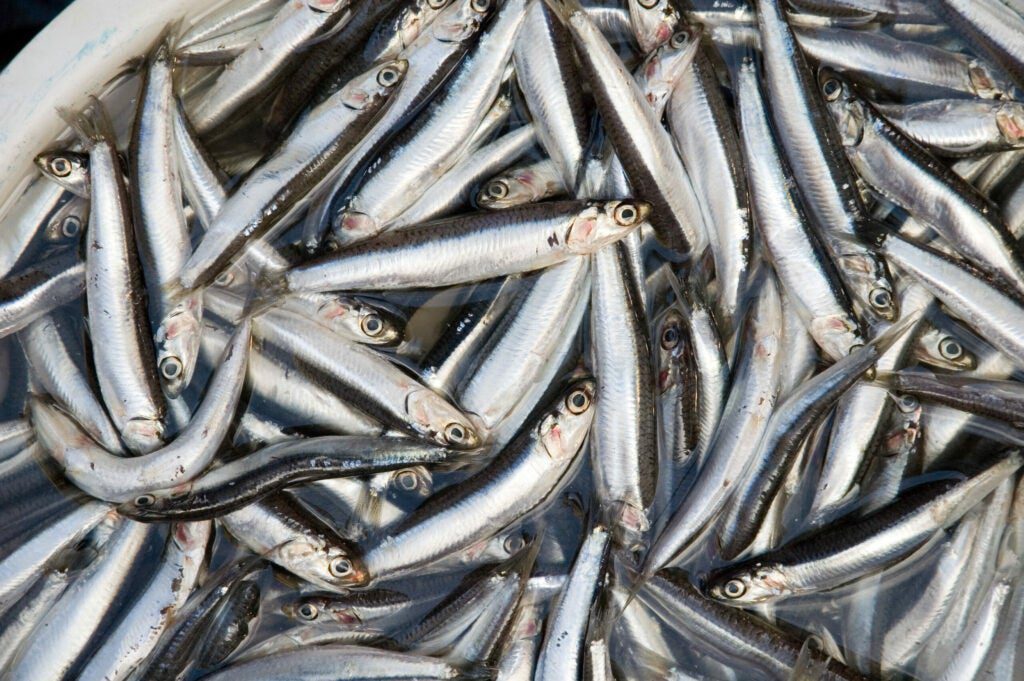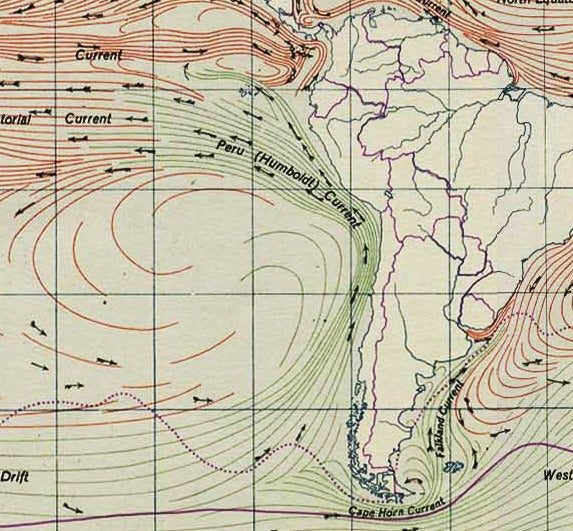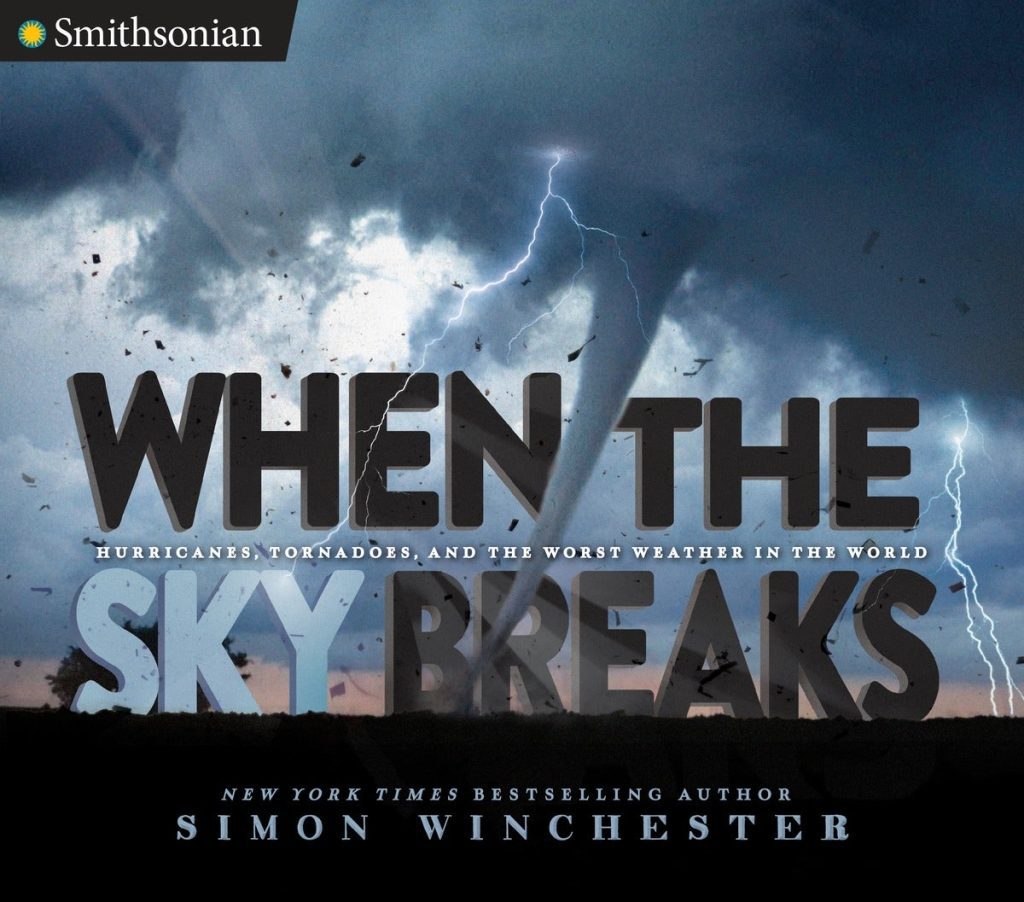The following is an excerpt from When The Sky Breaks by Simon Winchester.
There is a growing realization today that the world’s weather is inextricably linked: weather is global. And the weather story of the planet begins in the world’s biggest ocean, the Pacific.
The Pacific Ocean is broiled by the sun, whatever the season. Because the Earth tilts on its axis, the northern parts of the Pacific are broiled in the northern summer, the southern parts in the southern summer. The miles of ocean that lie between the Tropics of Cancer and Capricorn are broiled all the time.
The effect of the thermal energy that blasts endlessly down on Earth from the sun differs depending upon whether heat strikes solid or liquid below. When intense sunshine radiates down onto solid earth, the rocks become very hot, very quickly. Because of the physics of solids, they release this heat equally fast and return it to the atmosphere, retaining very little. To a wanderer in some hot deserts, a rock at nighttime can be blessedly cool. It’s always different at sea.
When the same intense heat radiates down onto the ocean, the water warms slowly at first, but it retains the heat it absorbs for a long time. Because it is a moving liquid, it then shifts this captured heat around. The ocean’s currents and its surface winds drive the captured thermal energy from side to side, either between the east and the west or the north and the south. Another, less well-known pattern of ocean movement known as thermohaline circulation can also shift this heat downward into the depths of the sea. Since the Pacific is by far the deepest ocean, as well as the broadest and longest, the amount of heat it can absorb and circulate within itself is almost beyond imagination.

Pacific Ocean
Heat, in immeasurable quantities, is stored in the world’s ocean generally, particularly in the Pacific, which occupies one-third of the planet’s entire surface area. Much of this heat then warms the atmosphere. It does so especially where the ocean is subject to the most intense solar heating: that wide band of water between the tropics and along the equator, a band that shifts to the north and the south as the seasons change.
Within this well-defined area, the intense heat causes the seawater to evaporate and the warm air above it to rise. Immense clouds form and billow skyward. As they rise, air pressure lowers in the void the clouds leave behind. Cooler and heavier air then pours in from the north and the south to fill this low-pressure zone. Thanks to the west-to-east spinning of the Earth, this air tracks in a more or less westerly direction as it cascades inward: the air from the north heading toward the southwest, the air from the south tracking to the northwest. Since, as we’ve seen, winds are named for the direction they are coming from, these inrushings of cool air become the famous trade winds—the northeast trades in the northern hemisphere, the southeast trades below the equator.
This tropical-equatorial band is where the climatic business of the world begins. It is where the trade winds blow (or don’t blow, if you hit the area of windless doldrums). It is where the monsoons begin their lives. It is where all the world’s cyclones and hurricanes and typhoons are born. And in the Pacific portion of this area—by far the largest—a series of curious atmospheric and oceanic events occur that appear to be most crucial to the creation of the world’s weather.
These occurrences are tangible, recognized, and recorded. As long ago as the late sixteenth century, South American fishermen working out of ports in the north of Peru, from Tumbes on the Ecuadorian border to Chimbote close to Lima, took note of what happened in the ocean waters. Their livelihoods depended on it—and modern weather science confirmed their findings.
Chimbote, Peru, came to be known as the world anchovy capital. The small silvery and smelly fish were found in staggering numbers in the cold waters just twenty miles (thirty-two kilometers) offshore; the little anchovies called anchovetas spawned a highly prosperous industry. Few fish have ever known such a boom: over the past century, Peruvian anchovy fisheries sprang up in every possible harbor along the coast. Thousands of fishermen worked the waters, eventually making the anchoveta the most exploited wild fish in the world. Thirteen million tons of the fish were hauled into the nets in 1971; most of it was ground into fish meal, or sent off to fertilize fields or feed livestock all across the world.

Anchovies
But the abundance of anchovies was a fitful thing. Chimbote fishermen saw that once every five or six years, usually in November or December, the anchovetas vanished. One day, there would be darts of quicksilver shoals all around; the next, nothing but the blue silence of the deep. And there was another thing: at the same time, the cold waters offshore that brought in the evening fog became warmer. The fogs vanished, the skies cleared.
The lack of catch frustrated the fishermen, to be sure, and they cursed their empty nets. But the absence of anchovetas had an effect that then spread all the way up the food chain. The gannets, cormorants, and pelicans that fed on the anchovies died, or they abandoned their nests. Chicks died waiting as their parents made futile long-distance searches for food. Squid, turtles, and even small sea mammals died also, because the water was too warm for them or there wasn’t enough food. These dead creatures floated to the surface in large numbers, creating small islands of decay, their gases so acidic, they blistered the paint on boat hulls. To the fishermen, the loss of anchovies was an economic disaster; but the smorgasbord of other deaths and absences—together with the disfigurement of their boats—made the event seem both curious and sinister. Because this phenomenon invariably arrived around the celebration of Christ’s birth, the fishermen, with a touch of bitter humor, called it El Niño de Navidad, “the Christmas Child.”
“El Niño” to describe the change in the weather was a phrase that first made it into the English language at the end of the nineteenth century, not so much for the fishermen’s misery but because of the specific reason for it: the change of the current in the waters below.

Humboldt Current
The cold waters of the Humboldt Current, part of the normal pattern of Pacific circulation, powerfully sweep Antarctic waters northward along the South American coast before heading west along the equator. During El Niño, this oceanic movement would be mysteriously disrupted. Instead the Humboldt Current would be replaced, or nudged farther out to sea, by an irruption of warm water. This warm water bullied its way down from the equator and smothered the upwelling of cold-water nutrients on which the anchovies fed. The little fish then went elsewhere, well beyond the reach of the Peruvian fishing boats.
At first it was simply this change of current and unusual warming of the ocean that was called El Niño. Then in the mid-twentieth century, oceanographers and climatologists realized that the change of currents off Peru was just one of many features of a much larger and more important phenomenon.
Many names are associated with the research that confirmed this. One person in particular is Gilbert Walker, a mathematician; a designer of flutes; a keen student of the boomerang and of the flight paths of ancient Celtic spears; an authority on the aerodynamics of birds’ wings and the formation of clouds; an advocate of both the sports of skating and gliding, and the use of statistics; and a civil servant in British India. Walker had a meteorological epiphany in 1924 that helped secure what would become the Pacific Ocean’s reputation as weather generator for the world.
Walker was appointed Director General of Observatories, India, in 1904, and spent twenty years puzzling over a mathematical means of predicting the monsoon. (He was inspired to do so because after the monsoon failed to arrive in 1900, a terrible famine had followed as a result.) While he did not solve the mysteries of the monsoon, Walker’s work still led to a globally significant discovery.
Based on his exhaustive analysis of decades of weather records from all across the British Empire, Walker was able to show that El Niño events that occurred off the Peruvian coast—the fishermen’s accounts were by now well known to scientists around the world—were in fact part of an enormous and all-encompassing transpacific set of weather patterns. These patterns turned out to be like a marine mirror. If something meteorological was happening on one side of the ocean, the exact opposite was happening on the other side. The same held true meteorologically across seasons or extended periods.
Periods of ocean warming here led to cooling ocean there. The Peruvian sea starvation during a locally warm-sea El Niño event would in time be followed by a local sea cooling and return to abundance, and that would be called (keeping to the Christmas-themed naming practice) La Niña. Floods on one side of the ocean led to droughts on the other. There were periodic swings in weather and in the human response to it. Sometimes there were more cyclones; sometimes there were fewer. There were years of failed monsoons and years of summertime drenching; periods of famine and periods of abundance; dust bowl summers, harvest-rich autumns, prosperity and ruin, peace and turmoil. Within the Pacific, around the Pacific’s coasts, and even, perhaps, beyond them and around the globe.
Sir Gilbert Thomas “Boomerang” Walker declared in the early 1920s that this was due to a previously unrecognized natural phenomenon. What drove the regular and dramatic changes in the Pacific weather, Walker said, must be some kind of repeating mechanism up in the atmosphere. Whatever it was, this pattern of invisible winds and movements seemed to operate as a kind of seesaw, a beam-engine balance moving around a central pivot that lay somewhere in the center of the ocean.
This axis seemed to hover around where the International Date Line crosses the equator, in the middle of that sprawl of limestone specks then known as the Gilbert Islands and the Phoenix Islands, now the Republic of Kiribati. Up on this side meant down on the other; high pressure here meant low pressure there; hot here, cool across the other side; cruelly wet in this place, bone-dry in that. It had a beautiful logic to it, and measurements taken over the years that followed have long proved Walker right.
The transpacific atmospheric wind pattern Walker discovered was eventually named the Walker Circulation in his honor. This wind pattern produced the back-and-forth, hot-and-cold, wet-and-dry, stormy-and-serene periods that seemed to dominate the tropical Pacific’s weather, which Walker named the Southern Oscillation.
The initials of Southern Oscillation combined with the initials of El Niño form ENSO, the acronym for what is undeniably Earth’s most important climatic phenomenon. If the Pacific is the generator of the world’s weather, then ENSO represents the turbines that power the generator, and the Walker Circulation is the force that sets the turbines spinning in the first place.
The Walker Circulation is caused by the existence of long-lasting cells of pressure in certain places around the ocean. There is generally high atmospheric pressure over the eastern Pacific. There is generally a large low-pressure area over the western Pacific, most notably around the sea-spattered islands of Indonesia and the Philippines, the area that oceanographers and meteorologists like to call the Maritime Continent. The air above the ocean then moves, as physics demands, from the high-pressure area to the low, in other words from east to west. The trade winds at the surface, which blow nearly constantly in this direction, are this movement’s very visible and familiar manifestation.
As the trade winds blow, they help push the warm waters of the tropical seas below them in the same direction. Incredible though this may sound, the sea then piles up very slowly and deliberately as a huge wave of water passes steadily across and into the western edges of the ocean. The western Pacific can sometimes be a full two feet higher than the waters in the east. Some of this warm water evaporates and helps create the giant cyclonic storms and typhoons, like Tracy and Haiyan, that form over the western seas. Some of the warm water dives down into the ocean, cools, and is returned to the east via deep ocean currents. In a normal series of years, this pattern is repeated again and again: the Walker Circulation of the air above; the migration of the seawater below; the explosive growth of storms in the far west Pacific; and the return of the cool and dry air and upwelling cool water (and the anchovies!) to the Pacific east. Calm and stability of a kind reigns.
But for unexplained reasons, the Walker Circulation sometimes changes. The trade winds weaken or falter or even reverse their directions, and then an El Niño period occurs, and the system changes with it . . . dramatically. Or the Walker Circulation can sometimes strengthen in the opposite manner and with equal drama; then the reverse, the phenomenon of La Niña, dominates the weather picture instead.
Tracking, measuring, and predicting the arrival of El Niño and La Niña has lately become a major element in worldwide weather forecasting and climate modeling. It is safe and reasonable to say that in the computation of the planet’s weather, all eyes are all the time on what is happening in the Pacific and on the behavior of the Southern Oscillations. A major El Niño event is said to be starting at around the time this book is being written (late summer 2015), and around the planet, concerned people are watching anxiously. For as the Pacific oscillates, so oscillates the world.
Excerpted from When The Sky Breaks by Simon Winchester, published by Viking Books for Young Readers January 2017. Published with permission of the publisher. Popular Science is delighted to bring you selections from new and noteworthy science-related books. If you are an author or publisher and have a new and exciting book that you think our readers would love, please get in touch! Send an email to [email protected].









